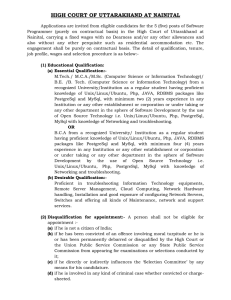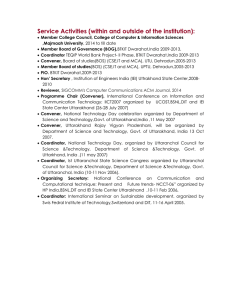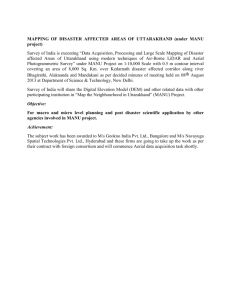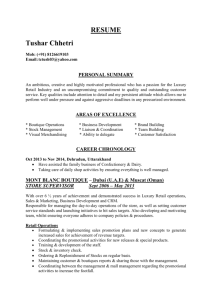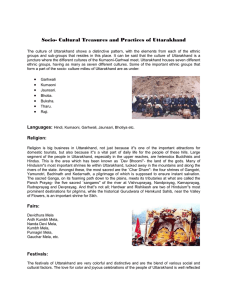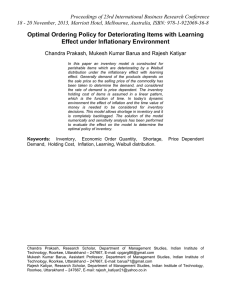HR Challenges in Managing Infrastructure Growth
advertisement
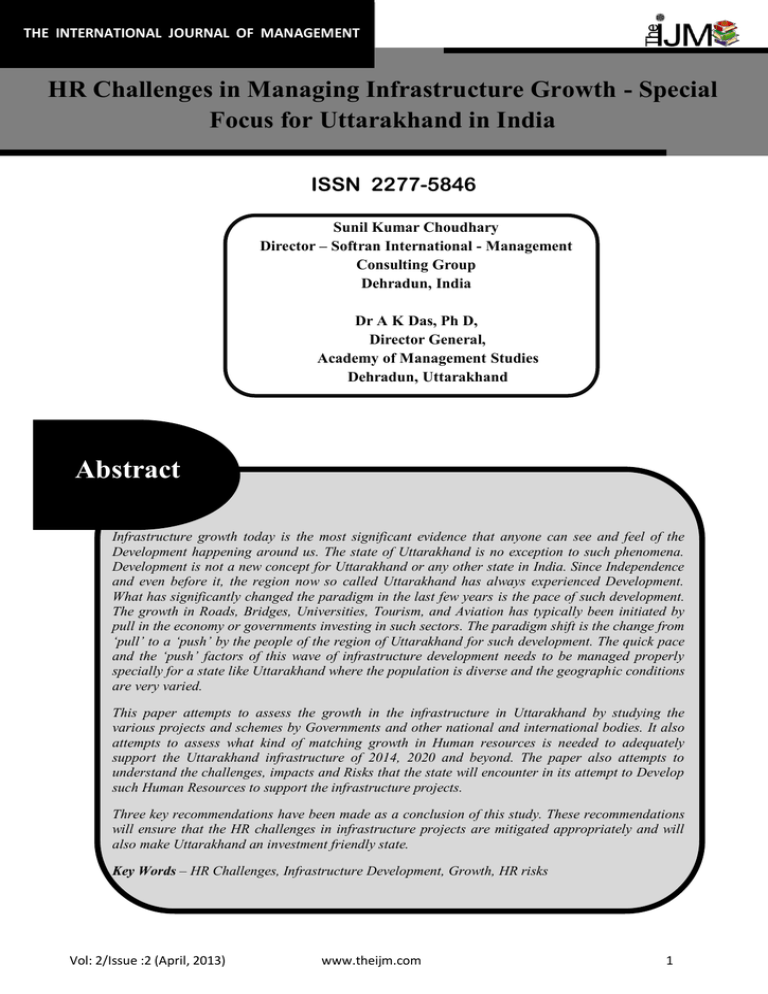
THE INTERNATIONAL JOURNAL OF MANAGEMENT HR Challenges in Managing Infrastructure Growth - Special Focus for Uttarakhand in India ISSN 2277-5846 Sunil Kumar–Choudhary ISSN 2277 5846I Director – Softran International - Management Consulting Group ISSN 2277 - 5846 Dehradun, India Dr A -K5846 Das, Ph D, 2277 Director General, Academy of Management Studies Dehradun, Uttarakhand Abstract Infrastructure growth today is the most significant evidence that anyone can see and feel of the Development happening around us. The state of Uttarakhand is no exception to such phenomena. Development is not a new concept for Uttarakhand or any other state in India. Since Independence and even before it, the region now so called Uttarakhand has always experienced Development. What has significantly changed the paradigm in the last few years is the pace of such development. The growth in Roads, Bridges, Universities, Tourism, and Aviation has typically been initiated by pull in the economy or governments investing in such sectors. The paradigm shift is the change from ‘pull’ to a ‘push’ by the people of the region of Uttarakhand for such development. The quick pace and the ‘push’ factors of this wave of infrastructure development needs to be managed properly specially for a state like Uttarakhand where the population is diverse and the geographic conditions are very varied. This paper attempts to assess the growth in the infrastructure in Uttarakhand by studying the various projects and schemes by Governments and other national and international bodies. It also attempts to assess what kind of matching growth in Human resources is needed to adequately support the Uttarakhand infrastructure of 2014, 2020 and beyond. The paper also attempts to understand the challenges, impacts and Risks that the state will encounter in its attempt to Develop such Human Resources to support the infrastructure projects. Three key recommendations have been made as a conclusion of this study. These recommendations will ensure that the HR challenges in infrastructure projects are mitigated appropriately and will also make Uttarakhand an investment friendly state. Key Words – HR Challenges, Infrastructure Development, Growth, HR risks Vol: 2/Issue :2 (April, 2013) www.theijm.com 1 THE INTERNATIONAL JOURNAL OF MANAGEMENT 1. Introduction: The Asia-Pacific region off late has been projected as the largest and fastest growing consumer market. China and India alone account for more than 30% of the growing economies of the world. This region along with ASEAN today is the largest supplier of manpower, largest consumer of goods and services and also boasts of one of the major regions where the workforce and the population that spends most is majorly below 30 years of age. All this has forced the region to develop their infrastructure if they wish to keep the pace of growth. Infrastructure growth today is the most significant evidence that anyone can see and feel of the Development happening in India. State of Uttarakhand in India is no exception to such phenomena. Development is not a new concept for Uttarakhand or any other state in India. Since Independence and even before it, the region now so called Uttarakhand has always experienced Development. However the Development of Infrastructure was limited to policies and projects of the central government. World aid organizations, private player‟s participation was unheard of. Infrastructure projects were looked upon as capital expenditures only with the view of social development. The Return on Investments (ROI) if calculated had a large Social component to it. However all this has changed since the 1990‟s. States and local governments in Uttarakhand are now taking initiatives in building the infrastructures of the local areas to attract foreign direct investments. A few reasons why foreign investors are willing to fund development in India are I. II. India has become a relatively safer country for foreign investments Government policies, single window for approval approach and other government initiatives have made it easy for foreign investors to invest and take profits back. A number of aid organizations like World Bank, Asian Development Bank (ADB) along with USAid have started projects on a large scale for infrastructure development. What has significantly changed the paradigm in the last few years is also the pace of such development. The growth in Roads, Bridges, Universities, Tourism, and Aviation has typically been initiated by push in the economy or governments investing in such sectors. ADB has invested in water and sewage projects for urban developments in Uttarakhand. The paradigm shift is the change from „push‟ to a „pull‟ by the people of the region of Uttarakhand for such development. This along with the tremendous economic growth (as according to Dr. Hiren M Maniar in his publication „Risk Analysis of Infrastructure Projects – A Case Study on Build – Operate - Transfer Projects in India „) in India has resulted in immense demand for basic infrastructure like roads, tunnels, power plants, water treatment plants and so on. If one fast forwards another 20 years, one can envision an National Capital Region (NCR – comprising of Delhi, Gurgaon & Noida) like city combining Haridwar, Dehradun and Rishikesh Vol: 2/ Issue : 2 (April, 2013) www.theijm.com 2 THE INTERNATIONAL JOURNAL OF MANAGEMENT with an International Airport and skyscrapers and eight lane highways connecting the downtowns of the three cities. Whether we achieve this vision or not depends on how well the growth in the infrastructure is managed. The quick pace and the „pull‟ factors of this wave of infrastructure development needs to be managed properly specially for a state like Uttarakhand where the population is diverse and the geographic conditions are very varied. Few of the key challenges for infrastructure projects that were highlighted by the Chief Minister of Uttarakhand to the Planning commission of India are I. II. Mountain topography (86%hillarea). Inaccessibility (2000 villages are situated at the distance of 05 KM and above from road head. About 5000 villages are not connected by roads. Almost all inaccessible villages are situated in hills.). III. Scattered habitations (50 % of villages are of less than 200 population & 80 % of villages are of less than 500 population. 50 % towns fall into the category of population less than 10,000.). IV. Uneconomic holdings in the hills (72% holdings are under category of marginal holdings & 47% holdings are below the size of 0.5 Ha). V. Almost entire state is identified under very high seismic zone (category V & IV). VI. A very agrarian population base with low rate of literacy In the next few years, Uttarakhand will see entry and growth of a number of new and old sectors of the industries. Creating special industrial zones like SIDCUL, Pharama-city, Tax Holiday heavens by the government will not suffice to support the infrastructure growth. A special emphasis is needed by private and public organizations including State government to support such growth. One, of the key areas where the government needs to invest and build support is the area of Human Resources. Do we have the adequately skilled manpower to support such phenomenal growth? Can the predominantly agrarian population of Uttarakhand support entry and sustenance of industries like oil & Gas, Power plants and Dry docks? Do the universities, ITI‟s and colleges supported by Central and State Governments have training courses to support Uttarakhand of 2014, 2020 and beyond. The past attempts in the state to Develop and Manage Human resources to match up with Development have not been very successful. A number of industrial units in Selaqui today are merely extensions of organizations from other states like Delhi, Andhra etc to take tax advantage. In the study carried out by the author, a majority of units have quoted lack of adequate work force and government support as a reason for these units from becoming full-fledged and contributing organizations. With fast track developments and a fairly backward population base it is very essential to consider the Human factors of such anticipated fast pace of infrastructure development. On the one hand, it is Vol: 2/ Issue : 2 (April, 2013) www.theijm.com 3 THE INTERNATIONAL JOURNAL OF MANAGEMENT crucial to address inequities and known challenges, while on the other, it is important to implement strategies for coping with the infrastructure developments and the progress they bring about in skills development for employability and sustainable livelihoods. 2. Objectives: The objective of this study is to a. Identify the challenges pertaining to HR related issues that the State of Uttarakhand faces and will face in future as a result of the infrastructure Developments b. Review similar situations across the globe in the field of infrastructure Projects and bring their learning‟s which will help the policy makers of Uttarakhand state. c. Identify the areas for the government and local bodies where they not only need to change their thinking but also train their own workforce to meet the challenges of the current fast track infrastructure developments in the state of Uttarakhand 3. Literature Review: According to Satya Ramamurthy in his article „The secret to Singapore‟s infrastructure success‟ states “Few cities are as revered by urban planners as Singapore. And for good reason: while the city-state has the highest population density in Asia, it also boasts the world‟s third highest GDP per capita and an unemployment rate below 2 percent. With more than 5 million people inhabiting less than 700 square kilometers (less than half the size of Greater London), all Singaporeans now live in urban areas”. The success of Singapore in infrastructure projects is unparalleled. The secret of this success as attributed by Chew Hock Yong, CEO of the Singapore Land Transport Authority in his own words is “When we look at planning in the long-term perspective, we often become more conscious about how our short-term plans fit into that long-term vision and what the implications are for the entire city “ . Infrastructure projects are like small and slow explosions which impact the social framework of the society and the worst hit is the human population of the region. It is very essential to manage and control such developments rather than leave it up-to the nature to correct the impacts. Coordinated strategies for long term in infrastructure development taking into account human resource impact and development are the only successful means of attaining success. In 2006, Korea was on the verge of becoming one of the ten most advanced countries; however the quality of life was the lowest among organization for economic cooperation and development members. Vision 2020 adopted by Korea took into account the Human Resource impacts and development and turned around itself by increasing the „spend‟ on social welfare especially in areas of infrastructure Vol: 2/ Issue : 2 (April, 2013) www.theijm.com 4 THE INTERNATIONAL JOURNAL OF MANAGEMENT developments. The Gujarat Infrastructure Development Board report „Review of Blueprint for infrastructure in Gujarat (BIG 2020)‟ also highlights the two key points namely I. II. Assess the impact of HR in the long, medium and short term of the development Strategize the infrastructure development taking into account the overall development rather than islands of development. Michael B Likosky, „Mitigating Human Right Risks under state financed and privatized infrastructure Projects‟, Indiana Journal of Global legal studies, Volume 10, Issue 2, speaks about projects like the Dam on Narmada river in India and the land based panama canal through Chiapas region as an example. These and similar projects were conceived without taking into account the Human resources aspects and ended up where many organizations local and international brought the Human Rights violations resulting in withdrawal of Finances for these projects. A number of Projects in China and Southeast Asia have carried the similar Human Rights Risks. On the flip side, Jose A valdez in the report titled „Human resource Issues in Private Participation in Infrastructure – Railroad Bolivia‟ provides a case study where by taking into account the HR aspects the Government and the private sector turned around the project into a roaring success and ensured the benefits of the infrastructure development were shared with the people, employed and displaced by the Project. The planning in this case also took into account the long term plan and adequately including the short and medium term plan and development of the Human Resources to support the project during the construction phase as well as during the operation phase post commissioning of the Project. 4. Study and Observations: Asian Development Bank, Government of Uttarakhand and JNURNM are currently executing a number of projects in Uttarakhand. The two key areas where the governments and local bodies need to address the HR challenges are I. Displacement Impact - The people impacted by the fast pace infrastructure developments – Displaced people due to the projects, impact of land acquisitions and relocation of HR or disturbance to HR on the ecosystems due to these projects. This could be primary or secondary displacement due to the infrastructure project II. Workforce Impact - The people required to execute such infrastructure projects and sustain them over the long term – Policies of the government bodies to re-skill the population through training or introducing education in universities & colleges to support such infrastructure developments. These re-skilling programs could be for as simple a case as farmers or fishermen leaving their habitats and re-locating to an industrial based habitat. Vol: 2/ Issue : 2 (April, 2013) www.theijm.com 5 THE INTERNATIONAL JOURNAL OF MANAGEMENT Displacement impact Infra Project Workforce Impact Figure 1 In the case of „Displacement impact’ of the developments, the governments at centre and in Uttarakhand state do not seem to have a precise policy on resettlement be it voluntary migration or involuntary resettlement. However some other agencies like the ADB or World Bank have their own policies on this matter. In India the state of Maharashtra has a “Maharashtra Project Affected Persons Rehabilitation Act, 1986”. States of Madhya Pradesh and Karnataka have also adopted similar acts. The first step for the Uttarakhand local bodies is to recognize the enormity of the problem and accept that lessons can be learnt from experience in other similar projects. Batang Ai Hydropower Project in Malaysia displaced 3600 people. The Jingjiu Railway project in China resulted in displacement of 210,000 people. Closer to home the Jamuna Multipurpose Bridge in Bangladesh displaced up to 65,000 people. Any infrastructure project which does not take into account the impact of displacements is not likely to succeed. Another offshoot that needs to be taken into account in all infrastructure Projects is the aspect of „Human rights risk‟. Infrastructure projects in many places are sites of human rights struggle. In the well know dam project along the Narmada River in Central India, World Bank withdrew the funding when the Human rights violations were highlighted by media and NGO‟s. Learning from the experience it is highly recommended that Uttarakhand Government make it imperative for all such projects to certify that the projects will not lead or account for any human rights violations. This along with a clear directive on the displacement impact will need to be included in the feasibility study and like environmental clearance; an HR clearance by experts should also be made compulsory for all infrastructure projects. The infrastructure case Vol: 2/ Issue : 2 (April, 2013) www.theijm.com 6 THE INTERNATIONAL JOURNAL OF MANAGEMENT study of the Railroad of Bolivia is such an example where the Ministry of Labor, Education, Law worked together to ensure adequate measures were part of the project to ensure the so called „displacement impact‟ was addressed. The case study clearly indicates that for the success of infrastructure projects the government has to play a very constructive role in ensuring that the Benefit getter from the project has to share the benefits with the displacement impacted populace and human Resources of the region. So very clearly the three major points the governments, Local Bodies should consider are I. A proper Displacement policy for the impacted populace – This policy should not merely compensation in terms of land or property but also consider the socio-economic impacts of the displacement such as the training and re-skilling needs of the displaced population. Farmers or Fishermen relocated from their original habitats and relocated to new sites need to be trained or re-skilled to become productive money earning members of the society II. HR Clearance like the clearance for environment impact should be included in the feasibility study – The HR Clearance would be given based on the section of feasibility study clearly outlining the probable Human right violation analysis and mitigation plan to ensure such violations are prevented or not committed. III. Benefit sharing from the infrastructure growth with the displacement impacted populace – The premise behind this aspect would be to ensure that the infrastructure growth benefits the investor as well as make the displaced populace financially sustainable in the long run. One such way could be to ensure the benefits are shared directly or indirectly in the form of job generations. The flyovers and highway constructions are an example whereby the displaced population is trained to man the toll booths or get involved as contractors in the construction and on-going maintenance of such projects. The responsibility lies with the governments and local bodies to ensure that such benefit sharing arrangements are agreed upon before the infrastructure project commences. The impact of the above three areas varies from region to region and from infrastructure project to project. However rarely do governments and local bodies have the right experts to understand and ensure reduced impacts of these areas. Governments and Local bodies need to engage full time Legal, financial, Human Rights and Human Resources experts. In a State like Uttarakhand where 20 to 30 such projects are being executed in parallel and each year 15 to 20 new infrastructure projects are initiated, the government and local bodies need to hire six to seven experts for each of these projects. Assuming that the existing workforce in the government or local body can handle such roles would not be a correct approach. The author would go one step further and recommend to the Vol: 2/ Issue : 2 (April, 2013) www.theijm.com 7 THE INTERNATIONAL JOURNAL OF MANAGEMENT government or local body approving authority that the project should not be approved unless these experts are employed or appointed by the local body or the government. The key parameter in the „displacement impact‟ is to keep in mind that a particular infrastructure project is not the first of its kind in the globe. A number of such or similar projects have been initiated and completed. Leaders in governments and local bodies should be willing to learn from the lessons of other geographic regions. Singapore‟s water conservation policies, Canada‟s rapid bus system are some examples where we can look for before starting similar projects in Uttarakhand. Smart grids are the need of the hour for each and every power generation and distribution organization. Reducing power losses and effective transmission are the goals shared by a number of companies in this arena. Each region has their unique challenges, yet there are commonalities which are opportunities of learning for the government leaders in the power sector. In Uttarakhand, One does not need to look very far when initiating infrastructure projects of Highways, flyovers, efficient transportation systems as all these have been accomplished in many states of India. Applying the Best practices, policies and learning‟s from such similar projects from other states of India will guide the officials of Uttarakhand government and local bodies to reduce the impact of „displacement impact‟. Asian Development Bank initiated the following projects in Uttarakhand namely. Primary goals involved improving the system to reduce water losses, reorganizing distribution networks, replacing old, damaged and undersized pipes, developing underground sewer networks etc. • Haridwar Water Supply Optimization Subproject • Nainital Water Supply Optimization Subproject • Dehardun Water Supply Optimization Subproject • Dehradun Rehabilitation of Sewerage System Subproject A similar Project with detailed overall policy and World Bank report had been undertaken before 2007. The report provides details of how the water supply and sewage system are part of the overall water conservation policy. A similar approach was however not adopted for the Uttarakhand project of Asian Development Bank. A number of learning‟s from this project could have been leveraged for more effective implementation and reducing the „displacement impact‟ of the project. The onus of the „displacement impact‟ lies solely with the government of Uttarakhand and the responsibility of employing and deploying experts in legal, financial, human rights and HR area to prevent or reduce „displacement impact‟ and learning from similar projects around the globe. The ‘Workforce Impact’ is another major area which has the potential to delay the fast pace growth the people of Uttarakhand are expecting. In his article Jatinder Singh states “Human resource Vol: 2/ Issue : 2 (April, 2013) www.theijm.com 8 THE INTERNATIONAL JOURNAL OF MANAGEMENT management in infrastructure industry is typically observed as an evolving rather than a strategic management process. There are capacity constraints coupled with lack of trained manpower and apt managerial skills posing an obstacle to standardize worker's job comparable to international standards. Construction industry employs about 31 million personnel which is second only to agriculture in terms of employment contributing 20% of GDP. Given the dominance of new institutional HR approaches in the analysis of working pattern of the workers, it is not surprising that the ambiguities and the effects of the use of training and development needs have been underestimated and at times not been attempted and explored. A well defined employee work dynamics poses restraints to uphold changes in the management styles facilitated by PEST (Political, Economical, Socio-cultural, and Technological) factors which have evolved the benchmarking of uniform HR practices. A changeover in mindset of HR planners right from the time of inception of management strategic planning needs to be done, otherwise this will create islands of excellence in the sea of mediocrity showing inconsistent and haywire job patterns in a diversified nation like ours” The government and Municipal establishments should envision the workforce impact and the areas which need to be considered as a part of this impact. The sole focus of the governments, municipal bodies today in India including that of the state of Uttarakhand has been to involve world aid organization and move forward with the infrastructure growth using the Public-PrivateParticipation model commonly known as the PPP model. One has to remember that the infrastructure development is not instantaneous and additionally the impact of this development has far reaching effects in the future and urbanization of the region. It has been observed all around the globe rapid urbanization goes hand in hand with the infrastructure development. A few prominent areas which need in-depth consideration are Long term urban planning in Uttarakhand – infrastructure developments will spiral urban migration and put pressure on city and state services, economies and infrastructure. City planners need to be involved or at least consulted to study the long term impact of migration to urban centers. It is not just the question of laying down more roads or pumping more water or supplying more electricity due to increased population, one has to study the long term impacts as more schools, jobs, offices, health facilities, workspace etc will be needed for the exploding urban population. The local and Government bodies need to have adequate HR Experts who can study this and anticipate the needs of the exploding populace. Once these impacts have been identified, the local and Government bodies need to provision such manpower of experts in the near to long future. Especially for a state like Uttarakhand where Vol: 2/ Issue : 2 (April, 2013) www.theijm.com 9 THE INTERNATIONAL JOURNAL OF MANAGEMENT we have to convert the agrarian population to take over these new areas of expertise. The Local talent needs to be nurtured by imparting the training or government working with Universities or local training organizations to support the need for skilled experts. The article „The British Columbia Transportation Industry Training Organization‟ details a very proactive approach in a scenario where the infrastructure growth motivated the government of British Columbia to establish a training organization to meet the growing needs of transportation industry Medium term to long term need for skilled and semi-skilled workforce – The infrastructure projects require a large number of semi-skilled workforce and relatively smaller number of skilled workforce. However what is different is the duration of these projects. These are not short term projects. Setting up a refinery or a university takes years. Construction of flyovers, Airports and highways is anywhere a project of three to five years. One also needs to thinks about the operation phase. Once commissioned, all such projects need semi-skilled and skilled workforce to operate the products of these projects. Government and Municipal bodies in Uttarakhand need to implement policies which encourage training institutes, local ITI‟s and universities to offer courses and on-job skills to support the Infrastructure Projects. Project Monitors for the Infrastructure Projects in Uttarakhand – All infrastructure projects in Uttarakhand are capital intensive and are being executed on the Public private partnership model. This is further complicated by the unique terrain and the agrarian populace of the state of Uttarakhand and the fact that each infrastructure projects has very unique characteristics. The infrastructure Projects also usually have a commissioning phase of anywhere between two to five years. All these parameters require not only a meticulous planning of the project but also very effective monitoring. The old model where government authority will monitor the project in places like Uttarakhand has failed miserably. Additionally more and more funding agencies like ADB, IDB and the World Bank are linking their funding with the satisfactory progress of the project. At each funding milestones these agencies are assessing the „displacement impact‟, „workforce impact‟ and any other such impact specific to the project like human rights risk etc. Keeping this in view, it is very essential that the government and municipal bodies appoint external consultants to monitor the progress of the infrastructure projects. These external consultants will have to be independent and their reporting at milestones should not be linked to their financial compensation. Furthermore these consultants should be from the local talent pools who are not only subject matter experts but also project management experts. Vol: 2/ Issue : 2 (April, 2013) www.theijm.com 10 THE INTERNATIONAL JOURNAL OF MANAGEMENT In the context of infrastructure projects the PPP model has been very successful around the world. However the PPP model has been tailored for each region for each project by the local experts. Additionally the PPP process cannot be rushed or imported and there is a lead time taken to develop this model. The approach of many Government agencies and also as observed for many government bodies in Uttarakhand, marrying the PPP model with the typical tendering process is not the correct solution. As of date the government bodies in Uttarakhand have numerous experts who have experience of tendering projects using the Request for Quotation and Request for proposal (RFQ/RFP) model. These models need to be evolved keeping in mind the nature of infrastructure developments, Displacement and workforce impacts and the risks like Human Right risks. Once again, there is a need to retrain the tendering experts of the government bodies to the new custom made model of PPP for Uttarakhand. This training will have to be continual as the PPP model evolves. Some of the key things one needs to keep in mind for Uttarakhand PPP model are • Infrastructure Projects in Uttarakhand require a larger upfront costs and the returns by the investors will be realized either at later stages of the project or post commissioning of the projects. This is typically true for Power generation units. This point is further complicated for Uttarakhand because of its hilly terrain. The government and local bodies need measures to mitigate this risk for the investors. Providing right and adequately skilled local human resources (Uttarakhandi‟s) to plan, monitor and execute the project in true terms of the partnership in PPP will make it more attractive for the investor to consider the infrastructure project in Uttarakhand at its inception stages. • Indian Government officials including that of Uttarakhand have enjoyed the reputation of meddling in the progress of the infrastructure projects. In a number of PPP projects the feasibility reports highlight this as one of the highest risks especially where investors have substantial capital investments in the project. Government bodies need to formulate policies to mitigate this risk at their own end. Appointing monitors who are independent and consist of local Talent pools can be a right step in this direction. Universities can be asked to form Management Consultancy units who can specialize in monitoring activities of such high value infrastructure projects in Uttarakhand. Such Consultancy units will develop project specific methodologies for periodic review of the contracts and ensure the risk-mitigations pertaining to Human Rights and Displacement impact are being properly addressed. Vol: 2/ Issue : 2 (April, 2013) www.theijm.com 11 THE INTERNATIONAL JOURNAL OF MANAGEMENT 5. Conclusion and Recommendations: The Study and the Survey clearly indicated that risks arising out of „displacement impact‟ and „workforce impact‟ needs to be taken into account for infrastructure projects. To mitigate these risks in Uttarakhand, government and local bodies will be required to change their policies and approach and include the following three points in their methodology for infrastructure projects in Uttarakhand 1. HR clearance for each infrastructure project should be a pre-requisite. This clearance will address the HR impacts and have mitigation for human rights risk. 2. Appoint independent project monitors from the local talent pool who will ensure that the various risks and mitigations including the HR Impact risks highlighted in the body of this article and relevant to Uttrarakhand are addressed during the entire lifetime of the project and beyond. 3. Procurement – Tendering and PPP models be customized to the needs of Project in Uttarakhand. This would require training and re-training of government agencies who are involved with the infrastructure projects. These three steps will go a long way in acknowledging the HR challenges of the infrastructure projects and also addressing these challenges in Uttarakhand and make it a more investor friendly state of India Vol: 2/ Issue : 2 (April, 2013) www.theijm.com 12 THE INTERNATIONAL JOURNAL OF MANAGEMENT References Books 1. De Cenzo, D. and Robbins, S. P., (1994), Human Resource Management: Concepts and Practices, New York: John Wiley and Sons Inc. Periodicals 1. Belout, A., & Gauvreau, C. (2004). Factors influencing project success: the impact of human resource management. International Journal of Project Management, 22(1), 1-11. 2. Bhirdikar, Kishire Bino, Paul G D, Venkatesha Murthy R. Journal of Social and Economic Development (Jan 01, 2011). “Understanding Labour Market Flexibility in India; Exploring emerging trends in Employment”, Publisher – Institute of Social and Economic Change; ISSN:0972-5792 3. David P Thomas, Ted Childs Jr, Ilene H Lang, Jack P Shonkoff, Jide J Zeitlin , The Centennial Global Business Summit – Harvard Business School – Summit Report 2008 – Managing Human Capital Global Trends and Challenges. 4. Huemann, M., Keegan, A., & Turner, J. R. (2007). Human resource management in the projectoriented company: A review. International Journal of Project Management, 25(3), 315-323. 5. Michael B Likosky, „Mitigating Human Right Risks under state financed and privatized infrastructure Projects‟, Indiana Journal of Global legal studies, Vol 10, Issue 2, Article 3 available at (access date – Feb 08, 2013) http://www.repository.law.indiana.edu/cgi/viewcontent.cgi?article=1265&context=ijgls 6. Project Administration Memorandum - India: Uttarakhand Urban Sector Development Investment Program – Project-1 (access date – Feb 09, 2013) available at http://www2.adb.org/documents/pams/IND/38272-IND-PAM.pdf 7. Satya Ramamurthy, „The secret to Singapore‟s infrastructure success „ - Insight – Global Infrastructure magazine – KPMG – Page 48, Issue No 2, 2011 8. Tabassi, A. A. and Baker, A. A.H. (2009). Training, Motivation and Performance: The Case of Human Resource Management in Construction Projects in Mashhad, Iran. International Journal of Project Management, Vol. 27, pp. 471–480. 9. Yankov, L. and Kleiner, B.H. (2001). Human resources issues in the construction industry. Management Research News, Vol. 24 Iss: 3/4, pp.101-105. Vol: 2/ Issue : 2 (April, 2013) www.theijm.com 13 THE INTERNATIONAL JOURNAL OF MANAGEMENT Electronic Sources 1. Fisher WL and Seals SJ.: “Human Resources: the Missing Piece of the Energy Puzzle,” Interstate Oil and Gas Compact Commission (IOGCC, 2001). 2. API: “Choosing Energy: Who Influences Future Engineers and Geoscientists?” American Petroleum Institute (2005). 3. National Petroleum Council – Technology Impact on Human resources Subgroup of the Technology Task Group of the NPC Committee on Global Oil & Gas – available at http://downloadcenter.connectlive.com/events/npc071807/pdfdownloads/Study_Topic_Papers/23-TTG-Human-Resources.pdf (accessed on Jan 04, 2013) 4. Jatinder Singh -„HR Challenges and Reforms in Infrastructure Industry‟ on the XXIII convention of Builders Association, Theme - „„Construction Labour - Issues, Problems, Future Trends and Talent Management in Building Construction‟ http://www.rbs.edu.in/research/hr.html (accessed on Jan 04, 2013) 5. BIG 2020 – GIDB Report available on http://www.gidb.org/downloads/vol_1b_summary_2020.pdf (access date Jan 27, 2013) 6. Republic of Korea – Country Infrastructure Report – 2020 (access date Feb 14,2013) available at http://www.unescap.org/ttdw/ppp/reports/republicofkorea_21sept2007.pdf 7. Dr Hiren M Maniar, Risk analysis of Infrastructure Projects, IUP Journal of Financial Risk Management, Vol II, No 4, Dec 2010 available at http://www.iupindia.in/1210/IJFRM_Risk_Analysis_of_Infrastructure_34.html 8. Jose Valdez - Case Studies in Human Resources issues in Private participation in infrastructure – Railroads in Bolivia http://rru.worldbank.org/documents/toolkits/labor/Toolkit/pdf/reference/valdez_2002_bolivia_rai lways_ppiaf_case_study.pdf (last accessed on Jan 04, 2013) 9. The British Columbia Transportation Industry Training Organization – (access date – Feb 03, 2013) available at http://www.itabc.ca/sites/default/files/docs/partners/TCDA/BC%20Transportation%20ITO%20 Mandate%20Statement.pdf 10. World Bank Analytical and Advisory Assistance (AAA) Program China: Addressing Water Scarcity – (access date – Jan 23, 2013 ) available at http://siteresources.worldbank.org/INTEAPREGTOPENVIRONMENT/Resources/WRM_Singa pore_experience_EN.pdf Vol: 2/ Issue : 2 (April, 2013) www.theijm.com 14
